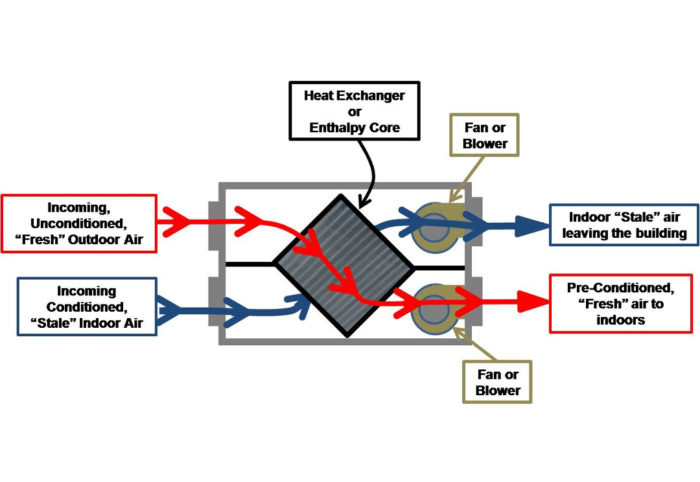Understanding HRV: A Complete Overview
How Heat Recovery Ventilation Boosts Indoor Air High Quality and Reduces Energy Costs
Heat Recovery Ventilation (HRV) systems play an essential duty in boosting interior air quality while at the same time reducing power expenditures. By successfully trading stale interior air with fresh outside air, HRVs assist preserve optimal humidity and minimize contaminants. In addition, their capacity to recuperate heat from outward bound air minimizes the strain on home heating and cooling systems. As energy costs remain to increase, recognizing the complete possibility of HRV systems becomes significantly vital for homeowners and services alike.
Recognizing Heat Recovery Ventilation Equipments

Heat recovery ventilation (HRV) systems play an essential duty in enhancing indoor air quality, specifically in modern-day, energy-efficient buildings. These systems are developed to transfer warm from the outward bound stagnant air to the inbound fresh air, thereby reducing power loss while keeping excellent temperature level degrees inside your home. HRVs consist of a heat exchanger, followers, and ductwork, assisting in the continuous circulation of air. By expelling indoor pollutants and introducing fresh air, HRVs aid to stabilize moisture degrees, avoid mold development, and lower irritants. The effectiveness of HRV systems hinges on their capability to recuperate as much as 80% of the warm from the tired air, promoting energy conservation while ensuring a healthy interior setting. Their combination is important in attaining sustainable living methods.
The Significance of Indoor Air Quality
Indoor air quality (IAQ) is a crucial factor affecting the wellness and wellness of residents in any setting. Poor IAQ can cause various wellness issues, consisting of respiratory system problems, allergies, and tiredness. Additionally, it can intensify status quo such as asthma. Factors adding to low IAQ consist of contaminants from indoor resources like cleaning up agents, mold and mildew, and poor air flow. Consequently, keeping great IAQ is crucial for promoting a secure and comfortable living or functioning area. Reliable techniques to boost IAQ include regular surveillance of air top quality, appropriate ventilation systems, and lessening using damaging compounds inside your home. By focusing on IAQ, individuals can ensure a healthier atmosphere that promotes performance and overall lifestyle.
Power Performance Conveniences of HRV Solutions
Many house owners and structure supervisors are significantly recognizing the power efficiency benefits of warmth healing air flow (HRV) systems. By moving heat from tired indoor air to incoming fresh air, HRV systems noticeably lower the power required for cooling and heating. This procedure lessens reliance on standard a/c systems, causing reduced energy costs. In addition, HRVs help keep a balanced indoor climate, avoiding excessive heating or cooling demands. The capability to recoup as much as 90% of the warmth from outbound air also supports sustainability initiatives by minimizing total power intake. Consequently, HRV systems contribute not only to cost savings however also to a reduced carbon footprint, aligning with the expanding emphasis on energy-efficient building methods.
Installment and Upkeep Considerations
The reliable application of warmth healing ventilation (HRV) systems additional reading needs careful factor to consider of installation and upkeep elements to assure peak performance. Correct positioning of the HRV system is important, as it needs to be set up in an area that maximizes air movement while reducing sound disruption. Furthermore, ductwork must be properly sized and shielded to avoid power loss. Routine maintenance, consisting of filter substitute and system cleaning, is essential to secure ideal capability and indoor air high quality. Proprietors should establish a regular upkeep schedule to determine and attend to possible issues prior to they intensify. Cooperation with knowledgeable experts throughout both installment and maintenance phases can improve the long life and performance of HRV systems, inevitably causing far better interior settings and decreased power expenses.
Real-World Applications and Success Stories
Discovering real-world applications of warmth recuperation air flow (HRV) systems reveals their significant effect on interior air quality and energy efficiency across various settings. In domestic buildings, house owners have reported improved air top quality, resulting in less allergic reactions and respiratory problems. Schools executing HRV systems have noted boosted student focus and decreased absenteeism because of much better air flow. Commercial buildings, such as workplaces and retail areas, have experienced reduced energy expenses and boosted staff member productivity. As an example, a company workplace in a pleasant climate achieved a find out here 30% decrease in power bills after installing an HRV system. These success stories demonstrate that HRV innovation not only adds to healthier settings yet also offers substantial economic advantages, making it a beneficial financial investment for various sectors.
Frequently Asked Questions
Can HRV Systems Minimize Allergens in Indoor Air?
The efficiency of HRV systems in minimizing indoor allergens primarily hinges on their capacity to filter and exchange air. HRV Heat Recovery Ventilation. By continually changing stale air, these systems can significantly decrease allergen degrees throughout interior settings

Just How Does Moisture Affect HRV System Efficiency?
Moisture greatly influences HRV system performance; high levels can result why not try here in condensation, minimizing performance, while reduced moisture might enhance air exchange. Stabilizing moisture is crucial for ideal operation and maintaining interior air quality.
Are HRV Solutions Noisy Throughout Procedure?
HRV systems can generate differing sound degrees throughout operation, depending upon their design and installment. Some systems run quietly, while others might generate recognizable sound, particularly at higher air flow setups or when badly kept.
What Is the Average Life-span of an HRV System?

Can HRV Solutions Be Used in All Climates?
HRV systems can be used in various environments, yet their efficiency might vary - HRV Heat Recovery Ventilation. In severe temperatures, modifications or supplemental systems could be essential to ensure excellent performance and convenience while maintaining indoor air high quality